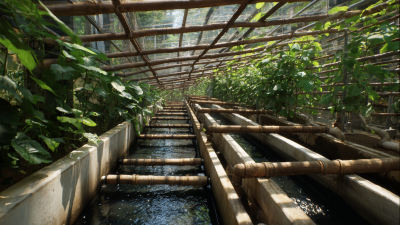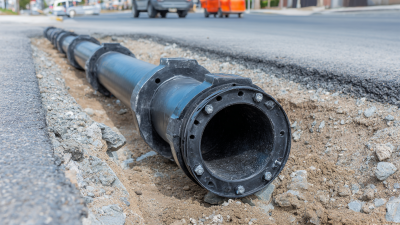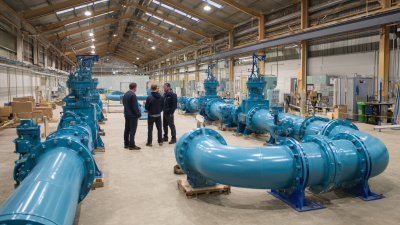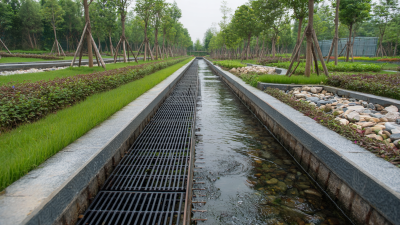In urban environments, the rise in extreme weather events and increased impervious surfaces have led to unprecedented flooding challenges. As cities expand, traditional drainage systems often fall short, prompting the need for innovative drainage solutions that can effectively mitigate these flooding risks. According to Dr. Emily Hartman, a prominent expert in urban hydrology, "Adopting cutting-edge drainage solutions not only enhances our ability to manage stormwater but also promotes sustainable urban development."
This statement underscores the critical importance of integrating advanced technologies and methods into urban planning. With climate change intensifying rainfall patterns, municipalities are compelled to rethink their approach to stormwater management. Innovative drainage solutions, such as permeable pavements, green roofs, and enhanced retention basins, are essential in creating resilient urban landscapes. As cities continue to grapple with the dual pressures of population growth and environmental sustainability, the exploration of these new strategies is not just beneficial—it’s imperative for future-proofing urban infrastructure.
The following discussion will delve into various innovative drainage solutions currently being implemented in cities around the globe, highlighting their effectiveness in tackling flooding and promoting a more sustainable future for urban areas.

Urban flooding is increasingly becoming a significant challenge for cities worldwide, emphasizing the urgent need for innovative drainage solutions. Among the most promising strategies is the implementation of nature-based solutions, which utilize the natural environment to manage stormwater and enhance urban resilience. Green infrastructure, such as permeable pavements, green roofs, and bioswales, not only absorbs excess rainwater but also improves air quality and supports biodiversity.
Implementing green infrastructure can be a practical approach for homeowners and city planners alike. **Tip:** Start with small installations like rain gardens or rain barrels to manage runoff in residential areas. These projects can serve as a pilot to demonstrate effectiveness and encourage broader adoption. Another effective measure is to involve community members in the planning process, ensuring that solutions meet the community’s specific needs and gain public support.
Additionally, the integration of urban agriculture into drainage solutions has proven beneficial. **Tip:** Consider transforming vacant lots into community gardens with retention systems that filter rainwater before it enters the city's drainage system. This not only mitigates flooding but also promotes local food production and strengthens community ties. By prioritizing these innovative green infrastructure solutions, cities can significantly reduce urban flooding while enhancing the overall quality of life for their residents.
| Solution Type | Description | Benefits | Challenges | Example Location |
|---|---|---|---|---|
| Bioretention Cells | Landscaped areas that capture and treat stormwater. | Improves water quality; enhances biodiversity. | Requires regular maintenance; space limitations. | City parks in urban areas. |
| Permeable Pavements | Paving that allows water to infiltrate through its surface. | Reduces surface runoff; lowers heat island effect. | Potential structural integrity issues over time. | Parking lots and streets in commercial districts. |
| Green Roofs | Vegetated roofs that absorb and filter rainwater. | Reduces stormwater runoff; improves insulation. | Higher initial costs; requires structural support. | Urban skyscrapers in metropolitan areas. |
| Constructed Wetlands | Engineered ecosystems that naturally treat wastewater. | Enhances ecological functions; provides wildlife habitat. | Land requirements and potential mosquito issues. | Stormwater management facilities nearby communities. |
| Rain Gardens | Shallow, vegetated depressions that capture runoff. | Reduces flooding; supports pollinator species. | Needs appropriate plant selection; limited capacity. | Residential neighborhoods and community parks. |
As urban areas continue to expand, the challenges of urban flooding become increasingly apparent. In response to these challenges, many cities are turning to smart drainage systems that leverage the latest advancements in technology for improved water management. According to the National Oceanic and Atmospheric Administration (NOAA), urban flooding has increased by 30% over the past three decades, highlighting the urgent need for innovative solutions. Smart drainage systems utilize sensors, data analytics, and IoT technology to monitor rainfall, manage stormwater in real-time, and optimize drainage operations, reducing the risk of flooding.
Recent reports from the Urban Land Institute suggest that cities employing smart drainage solutions can decrease flooding by up to 50%, saving millions in infrastructure repair costs and enhancing public safety. For instance, cities like Singapore and Amsterdam have successfully implemented smart drainage systems that integrate weather forecasting and real-time data collection. These systems not only manage excess water but also promote environmental sustainability by allowing for rainwater harvesting and improved water quality in urban areas. By harnessing technology, these solutions pave the way for more resilient urban environments capable of adapting to the impacts of climate change.
Urban flooding presents a significant challenge for many cities, exacerbated by heavy rainfall and inadequate drainage systems. One innovative approach to mitigate flooding is the implementation of permeable surfaces. These advanced pavement designs allow water to infiltrate the ground rather than run off into storm drains, creating a more sustainable urban environment. By using materials such as permeable asphalt or concrete, cities can effectively reduce the volume of water that contributes to urban flooding.
Tips for integrating permeable surfaces into urban planning include assessing the specific needs of different areas. For example, high-traffic zones should utilize durable permeable materials that withstand heavy loads while maintaining water permeability. Additionally, incorporating green infrastructure such as rain gardens or bioswales alongside permeable pavements can further enhance absorption and improve aesthetics.
Another tip is to consider maintenance practices for permeable surfaces. Regular cleaning and maintenance are crucial to prevent clogging and ensure optimal performance. It’s essential for city planners and property owners to collaborate on maintenance plans that include periodic inspections and necessary interventions, promoting long-term sustainability and effective water management.
Community engagement is vital in addressing urban flooding challenges, especially as cities become increasingly vulnerable to extreme weather events. Reports indicate that effective community involvement can enhance drainage planning by incorporating local knowledge and priorities. According to a study by the Urban Water Institute, cities that actively involve citizens in drainage planning can achieve up to 30% greater efficiency in their flood management systems. This collaborative approach not only fosters a sense of ownership among residents but also leads to the identification of culturally relevant solutions that might otherwise be overlooked.
Moreover, community engagement can facilitate better communication regarding flooding risks and available resources. The National Oceanic and Atmospheric Administration (NOAA) highlights that informed communities are more likely to implement personal preparedness measures, reducing the overall impact of flooding. By hosting workshops, creating participatory design sessions, and using digital platforms for feedback, cities can harness collective insights that enhance drainage infrastructure. This approach ultimately leads to more resilient urban areas capable of withstanding the increasing challenges posed by climate change-induced flooding.
Urban flooding has emerged as a significant challenge in modern cities, necessitating a reassessment of drainage solutions. Integrated approaches that combine traditional methods, such as canals and ditches, with contemporary innovations like permeable pavements and green roofs, present a comprehensive strategy for addressing urban flooding. These blended solutions recognize the importance of not only managing rainfall but also facilitating groundwater recharge and reducing runoff.
The integration of natural elements into the urban landscape can enhance the resilience of cities. Techniques such as bioswales, which utilize landscaped gutters to absorb rainfall, work alongside traditional drainage systems to alleviate pressure during heavy rain events. Moreover, technological advancements, such as real-time monitoring of water levels and predictive analytics, can optimize the efficiency of these combined systems, allowing for proactive measures rather than reactive responses. By merging tried-and-true methods with new technologies, urban planners can create a holistic framework that not only mitigates flooding risks but also promotes sustainable urban development.






